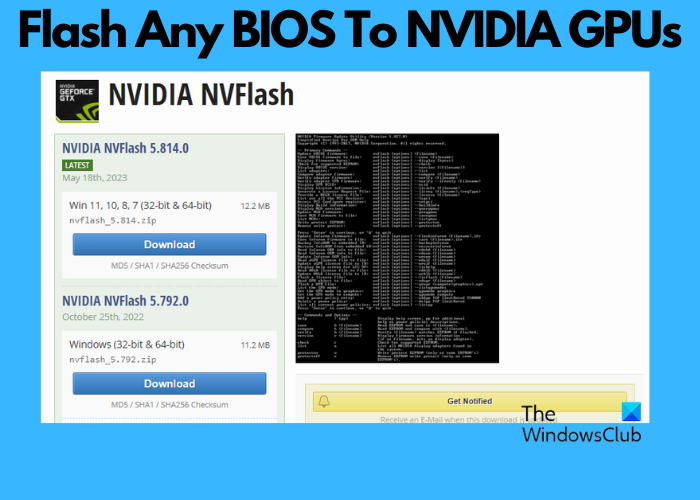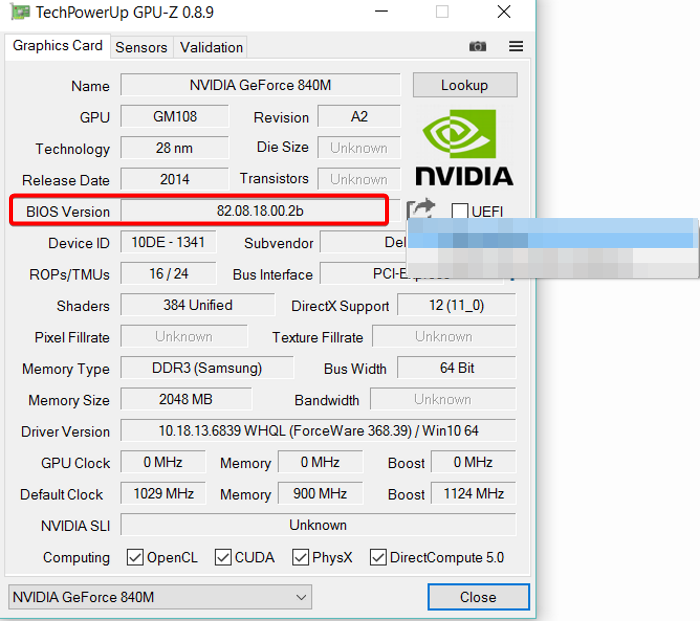You can flash a BIOS to NVIDIA GPUs using the newly released BIOS flash utility called NVFlash. Just like the BIOS on Windows, the BIOS of your NVIDIA or AMD ( called vBIOS) is the firmware or the chip of the graphics card. This chip stores all the required hardware settings for the graphics card. So, when overclocking or installing the latest drivers fail, that’s when you can flash the NVIDIA BIOS to get the best performance.

Flash any BIOS to NVIDIA GPUs with NVFlash
Not all graphics cards provide the option to be flashed with any firmware, except only NVIDIA and AMD. In this post, we will discuss how to flash any BIOS to NVIDIA GPUs with a special tool like NVFlash.
- Preliminary requirements
- Download the required tools & locate the current vBIOS version
- Backup the old firmware & clear protection
- Flash the BIOS of the NVIDIA GPU with NVFlash
1] Preliminary requirements
NVFlash supports BIOS flashing on the below-mentioned NVIDIA Graphics cards and more:
- GeForce RTX 3090, RTX 3080, RTX 3070, RTX 3060 Ti, RTX 3060
- GeForce RTX 2080 Ti, RTX 2080, RTX 2070, RTX 2060, GTX 1660, GTX 1650
- GeForce GTX 1080 Ti, GTX 1080, GTX 1070, GTX 1060, GTX 1050
Also, before using NVFlash, it will double-check a few parameters.
2] Download the required tools & locate the current vBIOS version

To begin with, download GPU-Z to find out the current version of vBIOS and also to back up the existing Firmware. That is, save it in a safe location so that you can go back to the old Firmware if needed.
Download NVFlash from Github to flash any BIOS to the NVIDIA GPU. At the same time, download the latest version of the graphics card’s BIOS (vBIOS) based on its vendor and the model from this Video BIOS Collection on TechPowerForums.
Now, check if the BIOS version of your NVIDIA GPU is the same as that on Video BIOS Collection. If it’s the same, then you do not need to flash the graphics card.
But, if the firmware is damaged or if you still want to flash the BIOS of the GPU, check GPU-Z or NVIDIA Control Panel to find the current version of the vBIOS.
Read: Best free tools to benchmark CPU and GPU on Windows computer
3] Backup the old firmware & clear protection

Now, unzip the downloaded NVFlash file in any folder, for example, C: \ nvflash \. Now, open the elevated Command Prompt, run the below commands one after another, and hit Enter after each command to save the existing/old firmware:
cd c:\nvflash nvflash64 --save ancienfirmware.rom
Now, run the below command to clear the protection and hit Enter:
nvflash64 --protectoff
4] Flash the vBIOS
Now, save the file (.ROM ) that you downloaded in the same folder as nvflash64.exe. Next, run the below command and hit Enter:
nvflash64 -6 -i0 titanxp.rom
Make sure to replace the “biofile” with the actual name of the file or rename the file. Now, wait for a few seconds and press Y to confirm the flashing. Keep pressing Y till you see the image back.
Once the flashing of the NVIDIA BIOS is done, restart your PC and reinstall the drivers if required.
Read: How to use the Quick Flash BIOS button on your computer?
Does flashing a BIOS void warranty on the GPU?
If the BIOS you are using is not released directly from the manufacturer, updating or flashing the BIOS on your machine may void the GPU warranty. This includes EVGA products. Hence, to avoid any issues with the warranty of the GPU, it’s essential to read the terms and conditions before you upgrade or flash the BIOS.
When should I flash my GPU BIOS?
Although it’s usually not recommended to flash the BIOS, it may be required if you are facing any hardware issues that a new BIOS version may fix. In such situations, flashing the BIOS can help update the hardware compatibility or fix specific bugs. However, since BIOS flashing carries some risks, it’s advised not to be done unless any specific reasons.
Leave a Reply